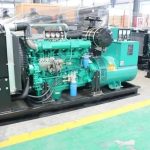Introduction
Diesel generators have long been utilized as a reliable source of backup power for various applications, including critical infrastructure, industrial facilities, and residential settings. One common challenge faced by diesel generators is the management of transient loads. Transient loads refer to sudden and temporary spikes in power demand that can occur due to the starting of large motors, sudden equipment operation, or other unpredictable events. In this article, we will explore the significance of transient loads on diesel generators and discuss strategies for optimizing their performance in handling such loads effectively.
Understanding Transient Loads

Transient loads can have a significant impact on the operation of diesel generators. When a transient load is applied to a generator, it can lead to voltage and frequency fluctuations, increased mechanical stress on the engine, and potential disruptions in power supply. These effects can compromise the efficiency, reliability, and longevity of the generator if not managed properly.
One of the primary causes of transient loads is the starting of induction motors. Induction motors require a high starting current that can be several times higher than their rated running current. This sudden surge in power demand can strain the generator and lead to voltage dips and frequency deviations. Other sources of transient loads include the switching on of heavy equipment, sudden changes in load demand, and grid disturbances.
Effects of Transient Loads on Diesel Generators
The impact of transient loads on diesel generators can be detrimental if not addressed appropriately. Some of the key effects of transient loads on generator performance include:
1. Voltage and Frequency Fluctuations: Transient loads can cause rapid changes in voltage and frequency levels, which can affect the stability of the generator output. Voltage dips or spikes can lead to equipment malfunction, data loss, and even damage to sensitive electronic devices.
2. Increased Mechanical Stress: The sudden changes in power demand associated with transient loads can result in increased mechanical stress on the generator components, such as the engine, alternator, and cooling system. This can accelerate wear and tear, reduce the lifespan of the equipment, and increase maintenance requirements.
3. Power Quality Issues: Transient loads can also impact the overall power quality delivered by the generator, leading to harmonics, voltage distortion, and other power anomalies. Poor power quality can affect the performance of connected loads and result in inefficiencies in the system.
Optimizing Diesel Generators for Transient Loads
To effectively manage transient loads and optimize the performance of diesel generators, several strategies can be implemented. These strategies aim to minimize the impact of transient loads on the generator, improve system reliability, and enhance overall efficiency. Some of the key optimization techniques include:
1. 500kw diesel generator for construction lighting Sizing of the Generator: One of the fundamental steps in optimizing a diesel generator for transient loads is to ensure that the generator is sized appropriately for the expected load profile. Undersized generators may struggle to cope with transient loads, leading to voltage fluctuations and potential equipment damage. Oversized generators, on the other hand, can result in inefficiencies and increased fuel consumption during low-load conditions.
2. Implementing Load Management Systems: Load management systems can help regulate the distribution of power during transient load events by prioritizing critical loads and shedding non-essential loads. By intelligently managing the power demand, load management systems can prevent overloading of the generator and ensure stable operation under varying load conditions.
3. Voltage Regulation and Frequency Control: Voltage regulators and frequency control devices can help stabilize the output voltage and frequency of the generator during transient load events. These devices monitor the electrical parameters and adjust the generator settings to maintain optimal operating conditions, reducing the impact of transient loads on the system.
4. Soft Starting Mechanisms: Soft starting mechanisms, such as variable frequency drives (VFDs) and soft starters, can be used to gradually ramp up the power supply to equipment with high starting currents, such as motors. By reducing the inrush current and minimizing voltage fluctuations, soft starters can mitigate the impact of transient loads on the generator and improve system reliability.
5. Energy Storage Solutions: Integrating energy storage systems, such as batteries or supercapacitors, into the generator setup can provide additional support during transient load events. Energy storage systems can store excess energy during low-load periods and release it instantaneously during high-demand situations, helping to stabilize the generator output and enhance system resilience.
6. Regular Maintenance and Monitoring: Proper maintenance and monitoring of the diesel generator are essential for ensuring optimal performance under transient load conditions. Regular inspections, lubrication, and component testing can help identify potential issues early and prevent unexpected failures during critical operations. Real-time monitoring systems can also provide insights into the generator's performance metrics and alert operators to any deviations from normal operating parameters.
Conclusion
In conclusion, optimizing diesel generators for transient loads is essential for ensuring reliable and efficient power supply in various applications. By understanding the effects of transient loads on generator performance and implementing appropriate optimization strategies, operators can minimize the risks associated with sudden power demand spikes and improve system resilience. Proper sizing, load management systems, voltage regulation, soft starting mechanisms, energy storage solutions, and regular maintenance are key elements in optimizing diesel generators for transient loads. By incorporating these strategies into their generator setup, operators can enhance system reliability, reduce downtime, and prolong the lifespan of their equipment in the face of transient load challenges.
